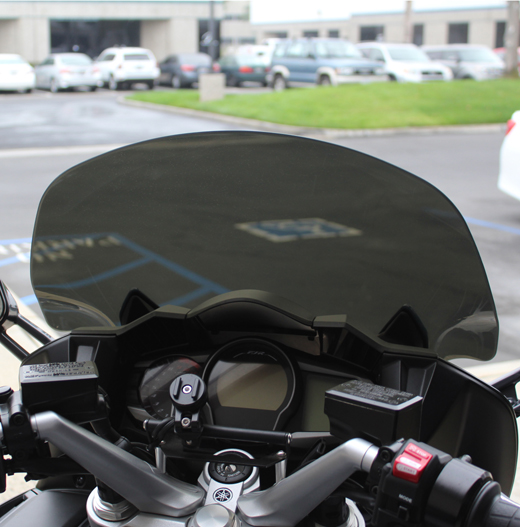1st quality screens are out of stock. Discounted Screens are available, https://aeroflowscreens.com/product/discounted-screens-yamaha/
Smooth, Quiet Ride
Our 2013-to-current FJR AeroScreen is designed to eliminate wind-noise, turbulence and buffeting all while looking over the top of the screen.
While AeroScreens retain full stock adjustability, optimum airflow occurs when the screen is raised 1″ to no more than 2″.The more you raise the screen, the more you cut off the airflow that travels along the backside of the windscreen which then increases backpressure.
A taller screen, run at lower positions, will offer better coverage and protection than a shorter screen raised higher than 2″.
Though the AeroScreens are shorter than the comparable stock FJR screens they provide both driver and passenger smoother airflow at lower screen height settings. Overall rider coverage and protection is greatly improved.
Wider than stock
We’ve moved the widest point of the screen down by 2 1/4″. By making the widest portion of our screens lower than stock, we’ve decreased the amount of air that sweeps around the screen as it’s raised.
Molded Flare on Sides
The molded flare from the lower sides, to above the mirrors, enhances the screen’s looks and is functional. The flares add rigidity to the screens that keep them from flexing in high winds or high speeds and helps direct the airflow out and away from both driver and passenger. The increased width and stability offers excellent, arm, shoulder and torso protection.
AeroScreen Dimensions and General Height Recommendations
Overall Screen Length
Standard AeroScreen: 18 1/2″
Tall AeroScreen: 21″
Extra Tall AeroScreen: 22 1/2″
Extra Extra Tall AeroScreen: 23 1/2″
Standard Yamaha screen: 19″
Tall Yamaha screen: 23″
General Height Recommendations
Our general rule of thumb is to go with the tallest screen that is nose to lip level when lifted 1 1/2″ to 2″ from full down. Part of the AeroScreen design is an increased air intake at the bottom of the screen, which allows air to travel along the backside of the AeroScreen. The air that is traveling along the backside of the AeroScreen combines with the air that’s traveling along the front of the screen, at the top curve or flare – this is how we achieve enough lift to clear your helmet. The higher you raise the AeroScreen, the air that travels along the backside gets cut off, which affects how much over-the-helmet air-lift you are able to achieve. So a taller screen raised just 2″ or so, would work better than a shorter screen raised all the way up.
Standard AeroScreen: Helmet coverage for riders up to 5’8″ or for riders that want a smaller than stock screen.
Tall AeroScreen: Riders 5’9″ to 5’11” that want smooth, turbulence-free cooling air when the screen is in the down position but over-the-helmet coverage when the screen is raised.
Extra Tall AeroScreen: Riders 6′ and up looking for a “Do It All” screen. Smooth, turbulence-free cooling air when the screen is in the down position and over-the-helmet coverage when the screen is raised. Stock seat, average torso, no bike modifications.
Extra Extra Tall: Another “Do It All” screen but for riders 6′ and up that have a longer torso, taller than stock custom seat, bar risers/backs and/or a combination of all.
Width at widest point of screen
Standard AeroScreen: 19 7/8″ at widest point. (Standard Stock: 19 5/8″ at widest point)
Tall, Extra Tall and XX-Tall AeroScreen: 21 5/8″ at widest point. (Tall Stock: 19 7/8″ at widest point)
Width at top of screen
Standard AeroScreen: 16 1/2″ wide at top. (Standard Stock: 14 7/8″ wide at top)
Tall and Extra Tall AeroScreen: 17 1/2″ wide at top. (Tall Stock: 16″ at top)
Fits
2013-on FJR1300’s








Reviews
There are no reviews yet.